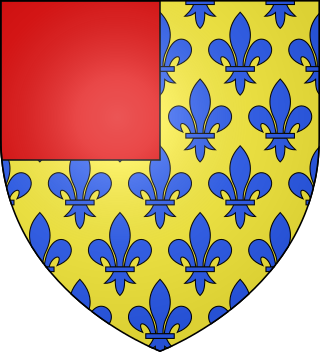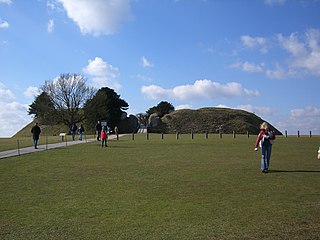Related Research Articles
Constance was Duchess of Brittany from 1166 to her death in 1201 and Countess of Richmond from 1171 to 1201. Constance was the daughter of Duke Conan IV by his wife, Margaret of Huntingdon, a sister of the Scottish kings Malcolm IV and William I.

Guy of Thouars was Duke of Brittany from 1199 to 1201 as the third husband of Constance, Duchess of Brittany. They married in Angers, County of Anjou, between August and October 1199 after her son Arthur entered Angers to be recognized as count of the three countships of Anjou, Maine and Touraine. He was an Occitan noble, a member of the House of Thouars.

Alix was Duchess of Brittany from 1203 until her death. She was also Countess of Richmond in the peerage of England.

The now-extinct title of Earl of Richmond was created many times in the Peerage of England. The earldom of Richmond was initially held by various Breton nobles; sometimes the holder was the Breton duke himself, including one member of the cadet branch of the French Capetian dynasty. The historical ties between the Duchy of Brittany and this English earldom were maintained ceremonially by the Breton dukes even after England ceased to recognize the Breton dukes as earls of England and those dukes rendered homage to the King of France, rather than the English crown. It was then held either by members of the English royal families of Plantagenet and Tudor, or English nobles closely associated with the English crown. It was eventually merged into the English crown during the reign of Henry VII of England and has been recreated as a Dukedom.
Richard de Lucy, Luci, Lucie, or Lusti, also known as Richard the Loyal, was first noted as High Sheriff of Essex, after which he was made Chief Justiciar of England.

Alan Rufus, alternatively Alanus Rufus (Latin), Alan ar Rouz (Breton), Alain le Roux (French) or Alan the Red, 1st Lord of Richmond, was a Breton nobleman, kinsman and companion of William the Conqueror during the Norman Conquest of England. He was the second son of Eozen Penteur by Orguen Kernev. William the Conqueror granted Alan Rufus a significant English fief, later known as the Honour of Richmond, in about 1071.
William des Roches was a French knight and crusader who acted as Seneschal of Anjou, of Maine and of Touraine. After serving the Angevin kings of England, in 1202 he changed his loyalty to King Philip II of France and became a leading member of his government.

The House of Tosny was an important noble family in 10th and 11th century Normandy, though it did not include any comtes or vicomtes. Its founder was Raoul I of Tosny.
Richard, Count of Évreux (c.1015–1067) was a powerful Norman nobleman during the reign of William Duke of Normandy.
Margaret of Huntingdon was a Scottish princess and Duchess of Brittany. She was the sister of Scottish kings Malcolm IV and William I, wife of Conan IV, Duke of Brittany, and the mother of Constance, Duchess of Brittany. Her second husband was Humphrey de Bohun, hereditary Constable of England. Following her second marriage, Margaret styled herself as the Countess of Hereford.

The Honour of Richmond was a feudal barony in what is now mainly North Yorkshire, England. The honour was two tiers below Yorkshire, the middle tier being the North Riding.

Hugh Bardulf or Hugh Bardolf was a medieval English administrator and royal justice. Known for his legal expertise, he also served as a financial administrator. He served three kings of England before his death.
Ida de Tosny, Countess of Norfolk, was a Norman royal mistress. Named after her grandmother Ida de Hainaut, she was the daughter of Ralph IV de Tosny and his wife Margaret, a daughter of Robert de Beaumont, 2nd Earl of Leicester.
Reginald de Warenne was an Anglo-Norman nobleman and royal official. The third son of an earl, Reginald began his career as an administrator of his brother's estates and continued to manage them for his brother's successor, William, the second son of King Stephen. Reginald was involved in the process that led to the peaceful ascension of Henry fitzEmpress to the throne of England in 1154 and served the new king as a royal justice afterwards. He played a minor role in the Becket controversy in 1170, as a member of the party that met Becket on his return to England from exile in 1170.
William of Évreux or William d'Évreux was a member of the House of Normandy who played an influential role during the Norman conquest of England, one of the few Norman aristocrats documented to have been with William I at Hastings. He was the count of Évreux in Normandy as well as additional lands and expanded his holdings by consenting to the marriage of his young ward and niece Bertrade to Fulk the Rude of Anjou, whose support against the Manceaux rebels was important for William's liege Robert Curthose. A feud between William's wife Helvise or Heloise of Nevers and Isabel of Conches, the wife of Raoul II of Tosny, led to open war between the two men. Helvise also governed Évreux in William's infirm old age until her own death. Having no children of his own, William was succeeded at Évreux by his sister's son Amaury of Montfort.
Robert fitzRoger was an Anglo-Norman nobleman and Sheriff of Norfolk and Suffolk and Northumberland. He was a son of Roger fitzRichard and Adelisa de Vere. FitzRoger owed some of his early offices to William Longchamp, but continued in royal service even after the fall of Longchamp. His marriage to an heiress brought him more lands, which were extensive enough for him to be ranked as a baron. FitzRoger founded Langley Abbey in Norfolk in 1195.
Walter de Clare or Walter fitzRichard was an Anglo-Norman nobleman and founder of Tintern Abbey. A member of a powerful family, Walter was a younger son who was given lands around Chepstow Castle by King Henry I of England sometime before 1119. Walter continued to appear in Henry's charters for the rest of the reign, and was an early supporter of King Stephen of England, Henry's successor as king. Walter last appears in the historical record in 1136 and died without children. His lands went to his nephew.
Rohese Giffard was a Norman noblewoman in the late 11th and early 12th century. The daughter of a Norman noble, she was the wife of another Norman noble, Richard fitzGilbert, who was one of the ten wealthiest landholders there after the Norman Conquest. Rohese is mentioned in Domesday Book as a landholder in her own right, something uncommon for women. She and Richard had a number of children, and she lived on past his death around 1086, until at least 1113 when she is recorded giving lands to a monastery. Her descendants eventually inherited her father's lands, although this did not occur until the reign of King Richard I of England.
Robert de Todeni, also known as Robert of Belvoir was an Anglo-Norman nobleman who held lands in England after the Norman Conquest.
Raoul I of Tosny was Lord of Conches, and probably an heir of Raoul, brother of Archbishop Hugh of Rouen.
References
- ↑ Marshall 2021, p. 121.
- ↑ Power 2004, p. 305.
- ↑ Power 2004, p. 433-435.
- ↑ Power 2004, p. 434-435.
- ↑ Power 2004, p. 435.
- ↑ Power 2004, p. 487.
- 1 2 3 4 5 6 Keats-Rohan 2002, p. 1138.
- ↑ Power 2004, p. 241.